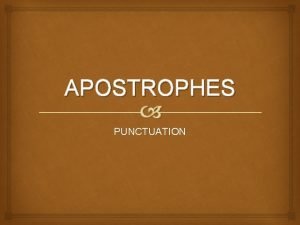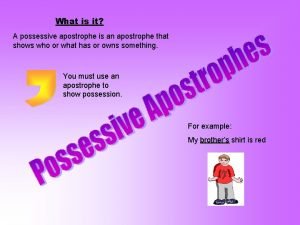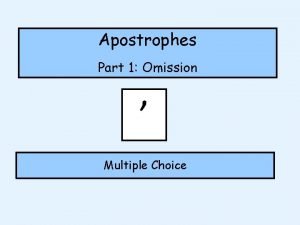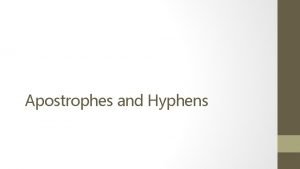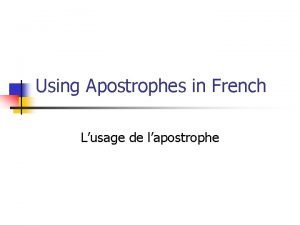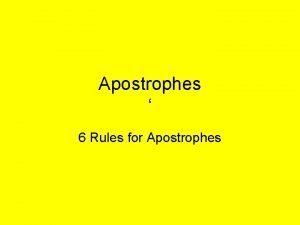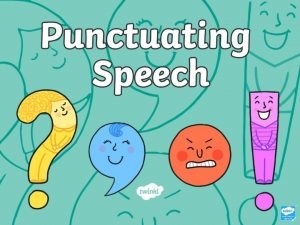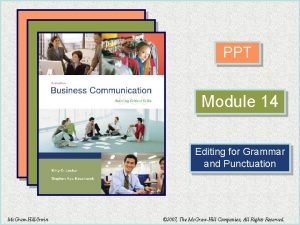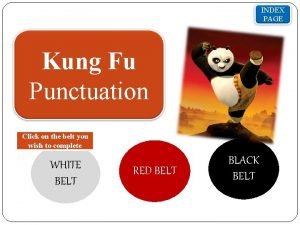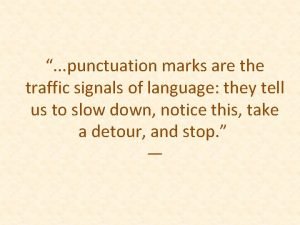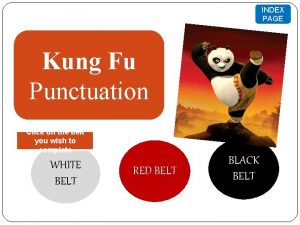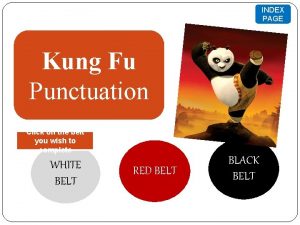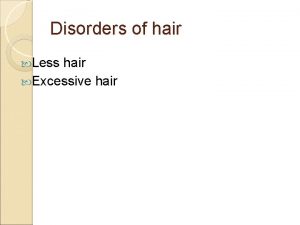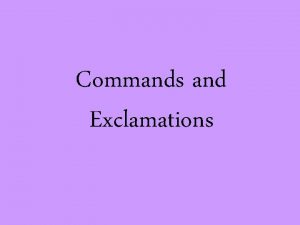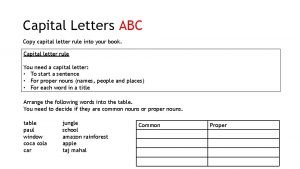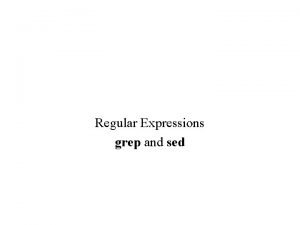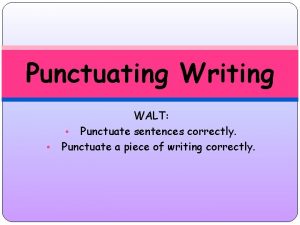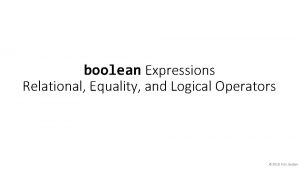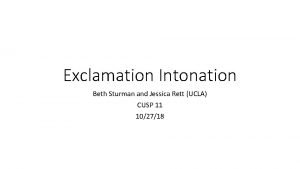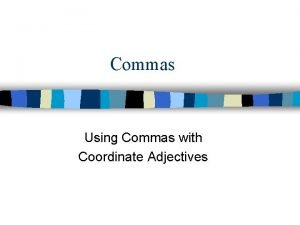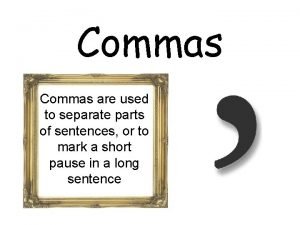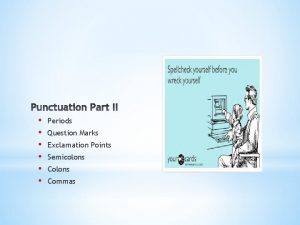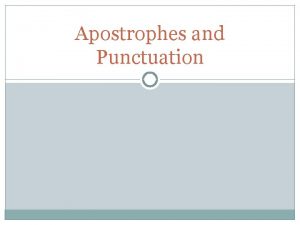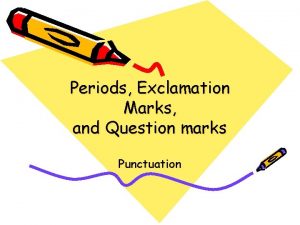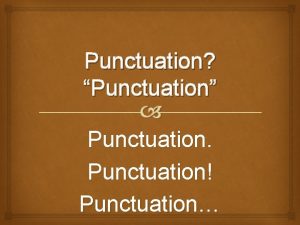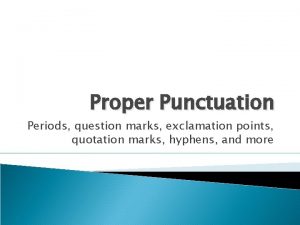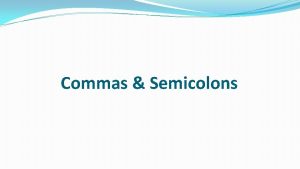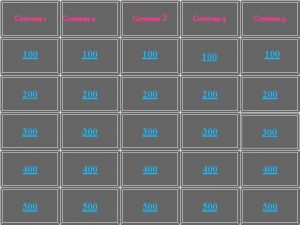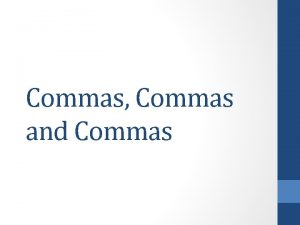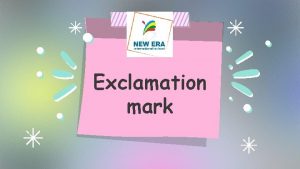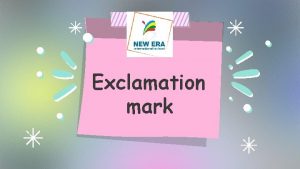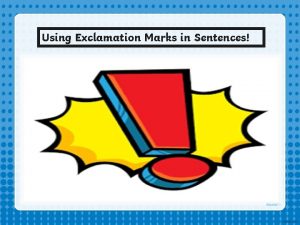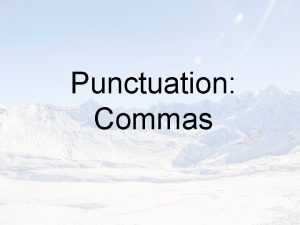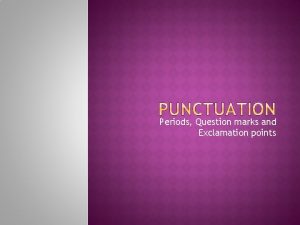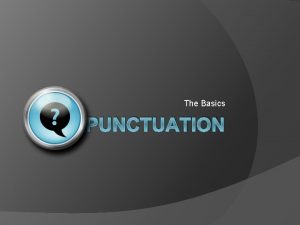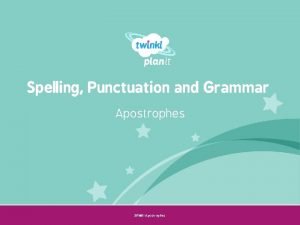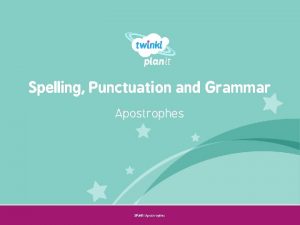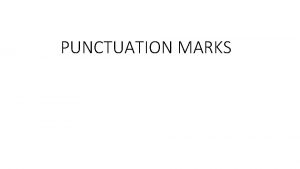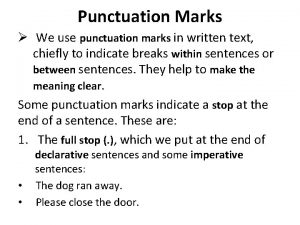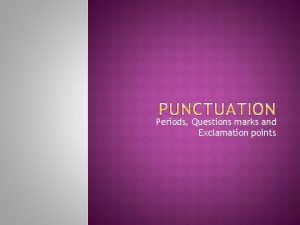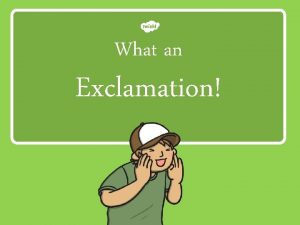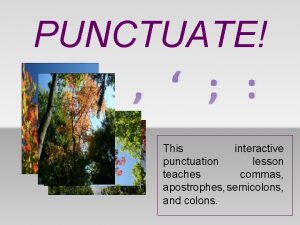PUNCTUATION Periods Question Marks Exclamation Marks Apostrophes Commas








































- Slides: 40

PUNCTUATION Periods, Question Marks, Exclamation Marks, Apostrophes, Commas, Semicolons, Colons, Dashes,

PUNCTUATION “Punctuation marks are the traffic signals of prose: they tell us to slow down, notice this, take a detour, and stop. ” - Lynne Truss 1. Woman without her man is nothing

PUNCTUATION 1. Woman, without her man, is nothing. 2. Woman: without her, man is nothing.

PERIODS A period is a full stop. It marks the end of a sentence. It marks the end of an idea or a thought. It marks the end of an action. Use a period at the end of an indirect question. - The teacher asked why Maria had left out the easy exercises. - My father used to wonder why Egbert's ears were so big. Don’t use a period with common abbreviations: - Johnny works for the FBI. - According to the Modern Language Association (MLA), this is correct. The MLA has many guidelines!

QUESTION MARKS Use a Question Mark at the end of a direct question. - Would you like to go to the store? - You like ice cream, don’t you? Question marks are used in academic writing to pose Rhetorical Questions. Those are questions posed not in order to elicit an actual answer but instead to make a statement. “But does the author address these concerns in a convincing manner? ” “Siebold uses many examples heroes using of guns to protect the innocent, but does he ever use examples of the innocent accidentaly wounding themselves or others with guns? ”

EXCLAMATION MARKS Don’t use them!

EXCLAMATION MARKS

COMMAS Let’s eat Grandpa. Six rules

COMMAS RULE 1: Direct Address Always use a comma when directly addressing someone/something, regardless of whether the direct address is at the beginning or end of the sentence. If the direct address is in the middle of a sentence, use a pair of commas to set off the direct address. - Let’s eat, Grandpa. - Steve, this steak is excellent! - I really do think, dear mother, that I am too old for diapers.

COMMAS

COMMAS RULE 2: Compound Sentences Use a comma and a coordinating conjunction (FANBOYS) to join two independent clauses. I am going to the mall, but I’m not going to buy anything.

COMMAS RULE 3: Complex Sentences and Introductory Material Use a comma after an introductory word, phrase, or dependent clause that comes before an independent clause. Word: No, I am not planning to go out this weekend. Phrase: After work, I’m going to the store. Clause: Before they go to school, the kids always have breakfast.

COMMAS RULE 4: Parenthetical Phrases Use commas to offset (or set apart) any word, phrase, or dependent clause that has been inserted into a sentence but is NOT ESSENTIAL to the main clause. The words and phrases often rename or tell more about the words they modify, and can, in most cases, be used as substitutes for those words. Because a comma is needed on either side, they are often referred to as PARENTHETICAL COMMAS. Michael Jackson, the greatest artist of all time, died a tragic death. Writing a letter of application that is clear, complete, and concise is a challenge.

COMMAS RULE 5: Introducing quotes Use a comma to shift between the main discourse and a quotation. Do not use a comma when embedding a partial quote in your writing. In 1848, Marx wrote, “Workers of the world, unite!” As opposed to In 848, Marx was not writing to the owners of the means of production; rather, when he used the word “Workers” he was only speaking to the proletariat.

COMMAS RULE 6: Separating Words Use a comma to separate thr ee or more items in a list, including l ist s of adject ives that describe a noun. The items may come in the fo rm of wor ds, phrases, or clauses. Words I am required to work on Monday, Wednesday, and Friday. Phrases I have always loved reading books, going to the park, and singing in the shower. Clauses I had a bad day because the police pulled me over, my boss yelled at me, and I was late for class. Adjectives Look at that brown, hairy dog!

COMMAS

THE OXFORD COMMA Otherwise known as the serial comma, we use this comma in lists before the word “and” § - I love the house, fence, and yard.

THE OXFORD COMMA

THE SEMICOLON The semicolon is used in two ways: - in place of a period to separate two Complete Sentences. - to separate items in a complex list.

THE SEMICOLON RULE 1: To make a COMPLEX list that requires commas easier to read and understand, put semicolons between the items instead of commas. I grew up in a series of small towns: Cumberland, British Columbia; Red Deer, Alberta; and Timmins, Ontario. NOTE: This is a rare use of the semi-colon.

THE SEMICOLON - I have been to Newcastle, Carlisle, and York. (commas used to separate the list items) - I have been to Newcastle, Carlisle, and York in the North; Bristol, Exeter, and Portsmouth in the South; and Cromer, Norwich, and Lincoln in the East. (semicolons used to separate the list items as the list items themselves contain commas) - You should choose ham, chicken, or char-grilled vegetable sandwiches; cups of tea, Bovril, or coffee (if you don't mind them lukewarm); or red wine (one of the few options that's drinkable when lukewarm)

THE SEMICOLON Rule 2: THE SEMICOLON replaces a period; it separates two sentences. When used in a sentence, it must appear between two independent clauses/sentences that can stand on their own.

THE SEMICOLON Rule 2: Good: I like ice-cream; I also like cake. The author claims that Johnny was shot by a nameless example of the neighbourhood thug that gives her community a bad name; the shooter is not an individual but a type.

THE SEMICOLON Rule 2: Bad: I like ice-cream; and cake too. The author claims that Johnny was shot by a nameless example of the neighbourhood thug that gives her community a bad name; not an individual but a type.

COLON The colon functions as an introducer. It alerts the reader that some sort of explanatory detail is coming up. The statement that comes before the colon must be an independent clause. It must be a sentence that can stand on its own.

COLON Not this: When I go to the game, I always bring: a chair, a blanket, and a hat. But this: When I go to the football game, I always bring supplies: a chair, a blanket, and a hat.

COLON EXAMPLE 1 It can be used before a list of one or more EXAMPLES that define, explain or illustrate the SENTENCE. When I travel, I am never without three things: sturdy shoes, a money belt, and my journal. There is only one enemy we cannot defeat: time.

COLON EXAMPLE 2 You can use it after a complete SENTENCE that introduces a quotation. Maude Barlow of the Council of Canadians encouraged young people to vote: “If you want to know who is going to change this country, go home and look in the mirror. ”

Warning! Explicit Lyrics! http: //www. youtube. com/watch? v=M 94 ii 6 MVilw

THE APOSTROPHE The apostrophe has two main uses: 1. Contractions 2. Possessives

THE APOSTROPHE 1. Contractions: when one or more letters are left out of a word, use an apostrophe to form a contraction. He would = he’d Cannot = can’t Should have = should’ve In academic writing we do not use contractions.

THE APOSTROPHE Possessives: use the apostrophe to show ownership. The word before the apostrophe is the owner. To see if you need to make a possessive, turn the phrase around and make it an "of the. . . " phrase. the boy's hat = the hat of the boy three days' journey = journey of three days If the noun after "of" is a building, an object, or a piece of furniture, then no apostrophe is needed! room of the hotel = hotel room door of the car = car door leg of the table = table leg

THE APOSTROPHE add “s” to the singular form of the word (even if it ends in -s): The man’s coat The boss’s idea James’s rebuttal add 's to the plural forms that do not end in -s: the children's game the geese's honking

THE APOSTROPHE add ' to the end of plural nouns that end in -s: two cats' toys three friends' letters the countries' laws add 's to the end of compound words: my brother-in-law's money add 's to the last noun to show joint possession of an object: Todd and Anne's apartment

THE APOSTROPHE Remember: pronoun possessives do not use an apostrophe: The board is meeting; its mandate is to increase profits Whose car is this? That is my car. Or wait, is it yours? Oh no! that car is hers!


THE DASH Wild Nights—Wild Nights! (249) Wild Nights – Wild Nights! Were I with thee Wild Nights should be Our luxury! Futile – the winds – To a heart in port – Done with the compass – Done with the chart! Rowing in Eden – Ah, the sea! Might I moor – Tonight – In thee!

THE DASH Dashes are used in two ways: 1. Like parenthetical commas to set off or emphasize the content enclosed within dashes Lasn describes the media—as corrosive and community destroying—throughout his essay. Davies cites his own superstitious ritual—he claims to have kissed a baby for luck—as proof that even the thoughtful and educated among us are prone to such behaviour.

THE DASH 2. Like colons to emphasis the content that follows a dash. Like a colon, you must either have an independent clause before the dash, or you must be using the dash to provide a definition. Donuts—they are not just for breakfast anymore! Lasn gives many examples of the media’s influence—and none of them are positive.

THE DASH Use sparingly in academic writing.
 When do you use exclamation marks
When do you use exclamation marks Costas level of questioning
Costas level of questioning Functions of apostrophe
Functions of apostrophe Apostrophe use possessive
Apostrophe use possessive The use of apostrophe
The use of apostrophe Apostrophes of omission
Apostrophes of omission Chomp chomp apostrophes
Chomp chomp apostrophes Show possession
Show possession Apostrophe en francais
Apostrophe en francais Apostrophe s rule
Apostrophe s rule Punctuation
Punctuation Put the correct punctuation marks in these sentences
Put the correct punctuation marks in these sentences 14 punctuation marks ppt
14 punctuation marks ppt Put the correct punctuation marks in these sentences
Put the correct punctuation marks in these sentences Formatting quotations and dialogue
Formatting quotations and dialogue Kung fu punctuation speech marks
Kung fu punctuation speech marks A clever dog knows its master
A clever dog knows its master Kung fu punctuation question mark
Kung fu punctuation question mark Punctuation marks make meaning clear.
Punctuation marks make meaning clear. Kung fu punctuation question mark
Kung fu punctuation question mark Exclamation mark hairs
Exclamation mark hairs Exclamation and command
Exclamation and command Dermatologist brighton
Dermatologist brighton What precautions best fits this pictogram
What precautions best fits this pictogram Do you use capital letter after colon
Do you use capital letter after colon Grep and egrep
Grep and egrep For example commas
For example commas What is a exclamation
What is a exclamation Exclamation intonation
Exclamation intonation Direct speech and indirect speech
Direct speech and indirect speech Quotations with question marks
Quotations with question marks When do we use question mark
When do we use question mark Transform direct questions into indirect questions
Transform direct questions into indirect questions Closed questions
Closed questions Compelling question
Compelling question Contoh remarks
Contoh remarks Compelling question meaning
Compelling question meaning Factor-isolating questions example
Factor-isolating questions example Present simple question words
Present simple question words Coordinate and cumulative adjectives
Coordinate and cumulative adjectives What is used to separate parts of any series
What is used to separate parts of any series


